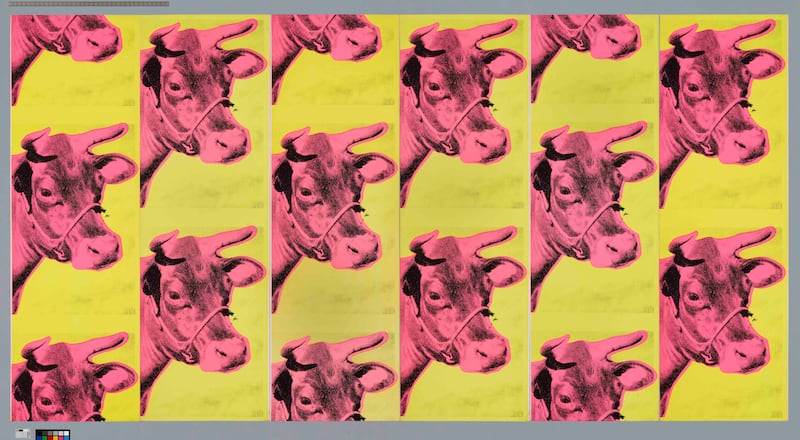PROVO — The American dream is often associated with the idea that anyone can make it in America.
But for 1960s Pop artists like Robert Indiana, the term might have been better defined as “anyone can buy anything.”
“Post-World War II, America has this economic boom, and because of that, there’s all sorts of fancy new modern mass-produced things being created,” said BYU Museum of Art curator Ashlee Whitaker. “America’s changing and it’s all this new kind of economic culture and commercial mindset, and advertising and media goes nuts, and that is a lot of what Pop is responding to.”
BYU’s Museum of Art is set to open an exhibition Friday titled “Supermarket: Pop Art and 1960s America from the Collections of Jordan D. Schnitzer and His Family Foundation.” that will feature more than 40 pieces — including Indiana’s “The American Dream” — by artists like Andy Warhol, Roy Lichtenstein, Claes Oldenburg, Jasper Johns, Robert Rauschenberg, Ed Ruscha, Wayne Thiebaud and James Rosenquist.
“We really wanted to get some of the most notable names in Pop art,” Whitaker said.
The show, which will remain open through March 28, 2020, will also exhibit works by some of the era’s female artists, including Salt Lake City-based Jann Haworth, Martha Rosler and Dorothy Grebenak. “Supermarket” also features art by Sister Corita Kent, a nun who made prints comparing Wonder Bread to the Eucharist.

The exhibition’s “Supermarket” title comes from Pop art’s response to consumerism and the fact that a majority of the works it features are prints.
“In the 1960s, printmaking becomes a really popular artform,” Whitaker explained. “These artists that are in the Pop mindset, they see how they can make their art mass-produced and available to the public, so it’s very democratic and consumable.”
BYU created the exhibition in collaboration with Jordan Schnitzer and his Family Foundation, which has amassed a collection of more than 13,000 modern and contemporary prints.
“There is I think a really appealing vibe about Pop — and we ourselves in our collection, we have some really nice Andy Warhol prints and some other Pop pieces, and so it was a chance for us to incorporate our own works in with this collection,” Whitaker said. “There’s just so many cool, relevant touchpoints for our campus community and our broader community.”
Whitaker said the more she studied Pop art while curating the show over the past two years, the more she felt “there were a lot of parallels that we can resonate with right now.”
“We’re having conversations about the bombardment of media in our lives, and we’re seeing people have dialogues about, ‘How do we step away from consumerism and all the things that we have, the me, me, me, me, me?’” Whitaker said.

“They become the property of the public, who just eat up their personal lives and their pictures and all this stuff. We still see that today. You could just put a different celebrity face up there for every year.” — Ashlee Whitaker, BYU Museum of Art curator
The exhibition features works like Lichtenstein’s “This Must Be the Place,” created in comic book format, and Warhol’s “$1.57 Giant Size,” based on ads. Whitaker noted a number of the artists in the show, such as Warhol and Rosenquist, started out as commercial artists.
“They were in advertising and media,” Whitaker said. “So they were aware of some of the strategies that marketing was using to make things visually appealing, to sell, so that plays into some of their work.”
Some Pop art pieces, like Warhol’s “Marilyn Monroe,” express the idea of celebrities also being a consumable commodity, as America became a “world superpower, not only economically, but also in terms of Hollywood and Pop culture,” according to Whitaker.
“They become the property of the public, who just eat up their personal lives and their pictures and all this stuff. We still see that today,” Whitaker said. “You could just put a different celebrity face up there for every year.”
Whitaker said 1960s Pop art also engages with political and social issues still prevalent today, such as race, gender and sexuality, making the exhibition “more than relevant” in 2019 and 2020.
“The ’60s, with all of its social and political turmoil and dynamism and change, I think that is something that we can relate to in our current moment in a big way,” Whitaker said.
Pop art is still prominent in today’s popular culture, Whitaker added.
“You see artists like Andy Warhol referenced in media and T-shirts and mugs and all sorts of things,” she said, “so Pop as an art style is something that is really familiar and accessible to a lot of people.”

If you go ...
What: “Supermarket: Pop Art and 1960s America from the Collections of Jordan D. Schnitzer and His Family Foundation”
When: Dec. 6, 2019-March 28, 2020
Where: BYU Museum of Art, North Campus Drive, Provo
How much: Free
Web: moa.byu.edu


